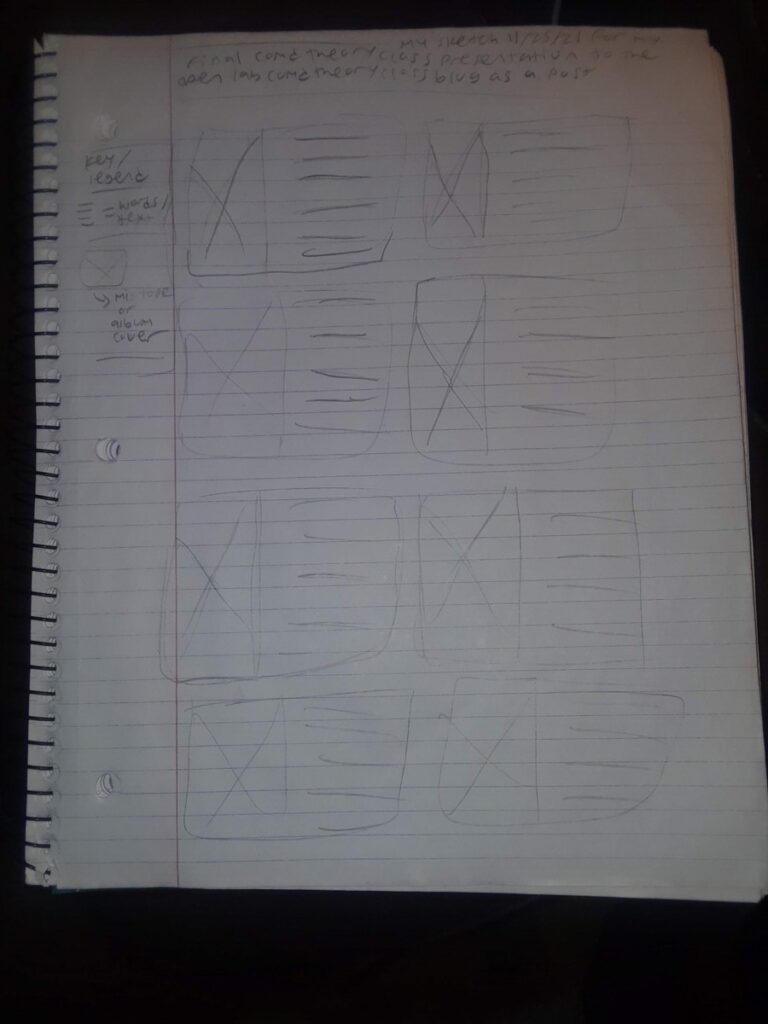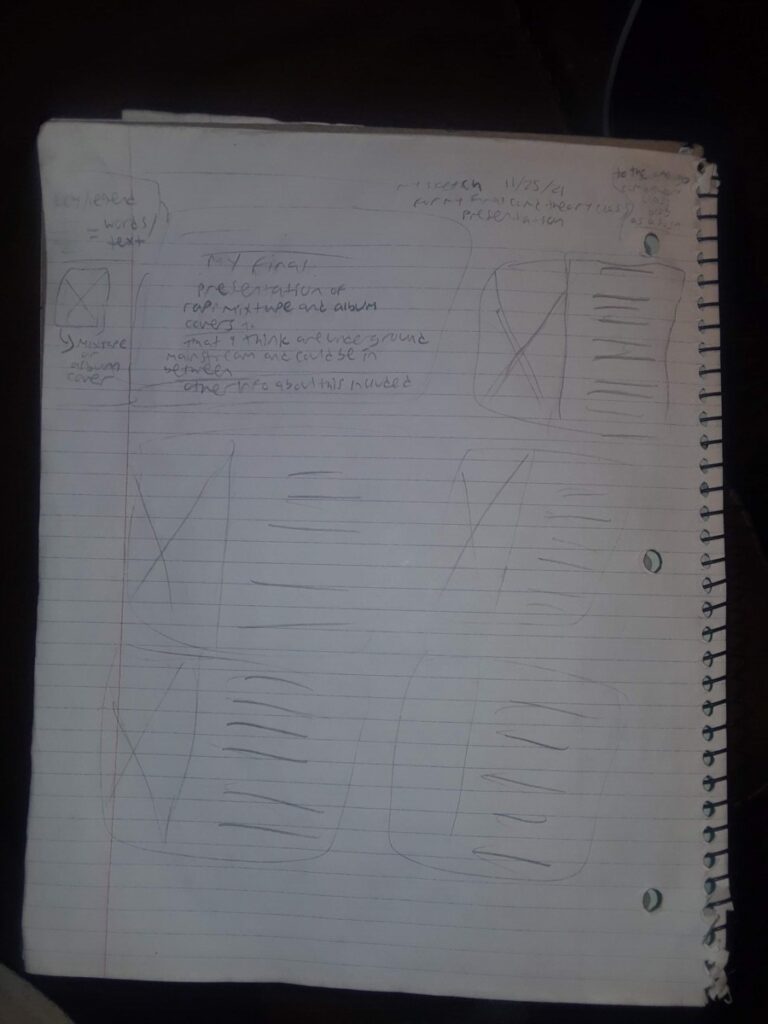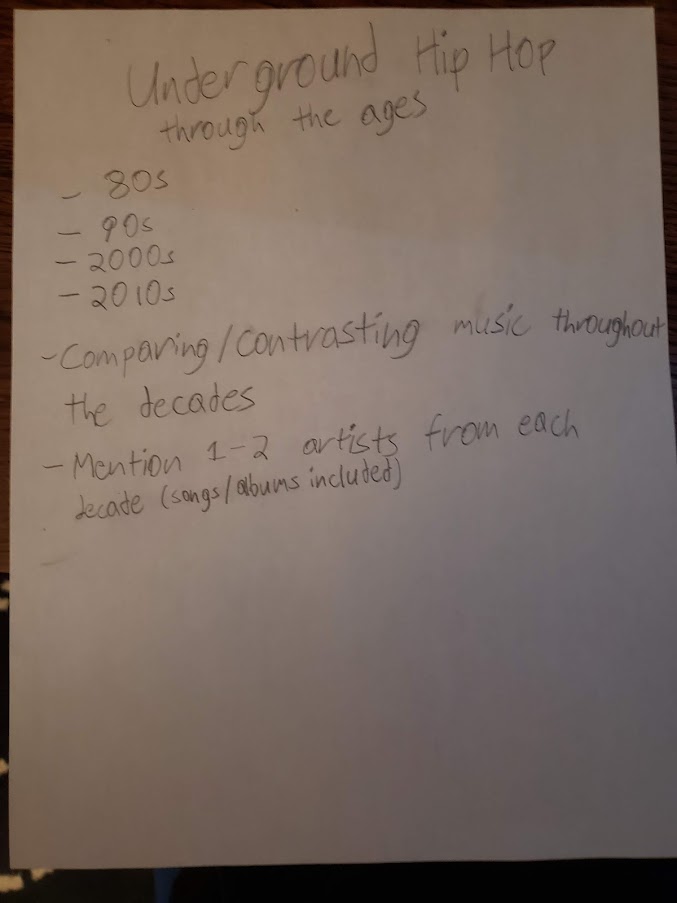Month: November 2021 (Page 2 of 7)


By the way my topic will break down some info about rap album and mixtape covers. I know it doesn’t have any words and pictures for these sketches, based on it. That’s because it’s going to be a surprise before tomorrow(tuesday). I hope you don’t lower my grade for this. Since for one thing, almost everyone loves surprises.
For Heller, the issue of mainstream vs. subterranean is essential in current design because, despite the style’s popularity, designers often duplicate or steal ideas. Heller introduces the argument in the paragraph that current design became significant because marketers were continuously looking for new methods to express themselves and relied on modern culture to do it. Some concepts were created by artists but were either borrowed or significantly changed to give the appearance of originality.
Where do For my final project, I will go into detail about Herbert Bayer’s work, and how his work changed the design society. The works that I will be addressing fits in this dichotomy because for the works that I will talk about, as many of Bayer’s works have sparked either a civic discussion or controversy in our society. “Advertising has been a favored target for social critics.”
The underground designs had no formal link with the designs that came to mind. They did, however, emerge as a byproduct in order to divert the public’s attention. It is in fact, that the underground appears to have just two options for dealing with the mainstream: join it or change it. The underground will either adhere to or disconnect from the ideology provided, depending on the individual and the ideology presented.
1). Barnard, Malcolm. Graphic Design As Communication, Taylor & Francis Group, 2005. ProQuest Ebook Central,
2). Meggs, Philip B., and Alston W. Purvis. Meggs’ History of Graphic Design, John Wiley & Sons, Incorporated, 2016. ProQuest Ebook
3).Graphic Design Thinking : Beyond Brainstorming, edited by Ellen Lupton, Princeton Architectural Press, 2011.
For our final reading assignment you will be responsible for reading two articles from Graphic Design Theory. More on that below.
The written portion for this week will not be a direct response to the readings. Instead, your assignment will be to post (1) “sketches” of your poster and (2) a working bibliography.
You can interpret sketches literally and/or loosely; include actual drawings, outlines of material, or brainstorms of related ideas. The bibliography can include relevant assigned readings, but it must also include at least 6 outside sources.
Back to the readings…again, you must read two articles from Graphic Design Theory, but this week you will decide which ones you would like to read. You may choose from:
Kenya Hara, Designing Design (2007):
Jessica Helfand, Dematerialization of Screen Space (2001):
Kalle Lasn, Design Anarchy (2006):
Ellen Lupton and Julia Lupton, Univers Strikes Back (2007):
Lev Manovich, Import/Export, or Design Workflow and Contemporary Aesthetics (2008):
Dmitri Siegel, Designing Our Own Graves (2006):
Jan Van Toorn, Design and Reflexivity (1994):
Feel free to email me with any project-related questions that might come up through the week.
Please also remember: we are looking for a handful of volunteers to present on the 30th. If you are able to assemble your resources and presentation before then, you are encouraged to volunteer. Early presenters will face lower expectations and will be graded with preferential status. I will also be happy to provide suggestions, comments or feedback on your work-in-progress.
Underground Art refers to when artists steal an artwork, alter a few aspects of it, and then sell it as an original. Despite the method used to create this are it actually gained a lot of followers. The reading makes it clear that “the phenomenon is not new, however. From the beginning of the twentieth century avant-gardes have ceded original ideas to the mass marketplace.” In some instances art can be a remix of someone else’s idea or even a combination of multiple people’s ideas. This is especially true with music. Different music styles, beats, and arrangements are copied and remixed all the time giving birth to new songs. Heller states in his reading “How can one design if the past is unknown? As a political tool it helps to understand the language of persuasion, even if the goal of the design brief is not to change politics.” From the moment it was created, art throughout the ages has been (fundamentally at least) a remix of what came before it.
Resources:
https://www.ukessays.com/essays/music/music-of-comparison-mainstream-and-underground-music-essay.php
According to Heller the concept of mainstream vs underground is relevant in contemporary design, because of the constant stealing of ideas from the underground by people in the mainstream. Heller continues to talk about how they will alter the work slightly if even that, then they reissue them, to the world as new products. As a result, sometimes the original work goes unnoticed while the copy gets a lot of credit. As a designer I couldn’t say I didn’t know that these types of things go on. It’s understandable to get inspiration from past products but to take old ideas and copy them just isn’t right and has a bad effect on the design world. For one when doing this you’re not really being creative and before you know it everyone will all have designs that look almost the same, which gets boring and would eventually lose the attention of the audience because it doesn’t intrigue them anymore. What gets your audience and get people looking at what your doing is your unique style and how you present things to them, it’s all about standing out.
For my presentation I will be doing a set of Nike posters from the 1990s, I wouldn’t say they necessarily stole ideas from the underground but used the fashion trends from the underground and incorporated these trends into their brand. Also, in some of the commercials they used popular hip-hop music and other genre to get the attention of the audience they wanted. they used athletes like Michael Jordan and celebrity like Spike Lee. When it comes to the designer, the phrase that he used was “Just Do It”. He stole this slogan from a man named Gary Gilmore, who when on death row said, “let’s do it”. Dan Wieden then took off lets and added just and that’s how Nike came up with there famous slogan. That’s one of the only times I can think of when they stole an idea or altered one to make a new product or campaign.
The specific posters I chose was the collaborations between Michael Jordan and Spike Lee. When reading an article on what was the inspiration for the ad campaign, I found they were trying to sell Michael Jordan sneakers, there were a bunch of Michael Jordan sneakers coming out at this time. When doing this Nike tried to tap into the “Sneaker Head Culture”. The shoe industry was growing fast, and people started to have somewhat of an addiction to shoes. Most people were fine with a couple pairs of sneakers, but some people were collecting more than a hundred pairs of shoes. Nike did an amazing job at marketing Jordans sneaker to the “Sneaker head Culture” and they took ideas from underground culture and alter certain things to make their ads more intriguing to the sneaker culture. I would say that this approach shaped the mainstream by showing companies in general that they can take styles and different concepts from the underground to help improve their consumer intake.
Sources:
https://nike-justdoit.weebly.com/influence-on-pop-culture.html
https://en.wikipedia.org/wiki/Sneaker_collecting
https://nike-justdoit.weebly.com/influence-on-pop-culture.html
The concept of mainstream vs. underground is relevant in contemporary design for Heller because although the style is very well-known, designers tend to copy or steal ideas. Think about it as recycling an idea. The only difference would be that people make these stolen ideas look brand new. For example, Heller said that, “Calkins commanded commercial artists to appropriate and smooth out the edges of modern art, add an ornament here and there to make it palatable for the consumer class, and—voila!—instant allure and immediate sales.” Even though this idea works in terms of marketing, there’s no original idea, and it gets very repetitive.
For my final project, I was going to talk about Michael Bierut, and how his work impacted the design world. The designs that I’ll be addressing fits in this dichotomy because for the pieces that I’ll mention, it almost seems as if what Heller has been saying is true. To add on, “designers can implement these same techniques to make unexpected use of both images and words. In writing, figures of speech often express ideas by evoking a mental picture. Such images help readers remember the message by casting a new light on familiar elements.” (1)
The sort of underground designs that influenced the work would be the pieces of work that the underground have produced. “Underground denizens attack the mainstream for two reasons: To alter or to join, sometimes both. Few designers choose to be outsiders forever.” In this text, they talk about how they always choose a side when designing. This shaped the mainstream by how designers always copy or renew a used idea. What’s important is that “the first function is the informative function. The role of graphics here is to impart (by definition new) knowledge, or intelligence.” (2) In terms of the future though, I feel like there will only be even more designers who copy and reuse the same idea, just as Heller explained. With that being said, many people during the 1970s were beginning a new design path, “By the 1970s many believed the modern era was drawing to a close in art, design, politics, and literature. The cultural norms of Western society were being scrutinized, and the authority of traditional institutions was being questioned.” (3)
(1) Graphic Design Thinking : Beyond Brainstorming, edited by Ellen Lupton, Princeton Architectural Press, 2011. ProQuest Ebook Central, http://ebookcentral.proquest.com/lib/citytech-ebooks/detail.action?docID=3387597.
(2) Barnard, Malcolm. Graphic Design As Communication, Taylor & Francis Group, 2005. ProQuest Ebook Central, http://ebookcentral.proquest.com/lib/citytech-ebooks/detail.action?docID=1273176.
(3) Meggs, Philip B., and Alston W. Purvis. Meggs’ History of Graphic Design, John Wiley & Sons, Incorporated, 2016. ProQuest Ebook Central, http://ebookcentral.proquest.com/lib/citytech-ebooks/detail.action?docID=4505417.
Hellers concept of mainstream vs. underground is an extremely relevant topic in current design. Memes have been a thing since the internets inception, and the book The Meme of Memes: information as Objects points out, memes have been a concept that has infiltrated media. The way that companies now are embracing the internet culture is equal parts cringy and impressive. Wendy’s, for example, has a huge presence on Twitter, delivering sassy jokes, roasting other users, and even insulting other fast food companies. Then of course many other companies have begun to follow suit, posting trending hashtags on their products and wording their advertising in a similar tone to that of Wendy’s. This infiltration of the “underground” internet culture into the mainstream is just one example of how, as Heller states, “commercial culture […] depends on the theft of intellectual property for its livelihood”.
In terms of my chosen designers work, Banksy, this dichotomy sort of exists in a smaller form. Banksy started out as a graffiti writer and then moved on to create stenciled artwork. Graffiti is highly frowned upon by authorities and a majority of people, yet it slowly moved from a public nuisance to high selling art pieces. In The Death of Graffiti: Postmodernism and the New York City Subway by Claudia Bennet, the author compares the framing of graffiti to a teenager buying pre-torn jeans, stating that “the jeans are flaunted by cliques who recognize the simulation and prefer it over the original, in much the same way as the gallery prefers spray paint on canvas to graffiti on its front door”. The same graffiti that could land Banksy in prison has slowly been turned into a significant art piece that people are willing to pay ridiculous amounts of money to possess. The art that Banksy once created that was a part of the underground scene has suddenly been taken out of where it belongs, “when it is relocated, it is destroyed’
Resources
López, Antonio. “Chapter Seven: The Meme of Memes: Information as Objects.” Counterpoints, vol. 343, Peter Lang AG, 2008, pp. 95–109, http://www.jstor.org/stable/42980181.
Cox, William. “The Underground Film in Art.” Art Education, vol. 26, no. 2, National Art Education Association, 1973, pp. 8–12, https://doi.org/10.2307/3191828.
Barnett, Claudia. “The Death of Graffiti: Postmodernism and the New York City Subway.” Studies in Popular Culture, vol. 16, no. 2, Popular Culture Association in the South, 1994, pp. 25–38, http://www.jstor.org/stable/23413729.




Recent Comments